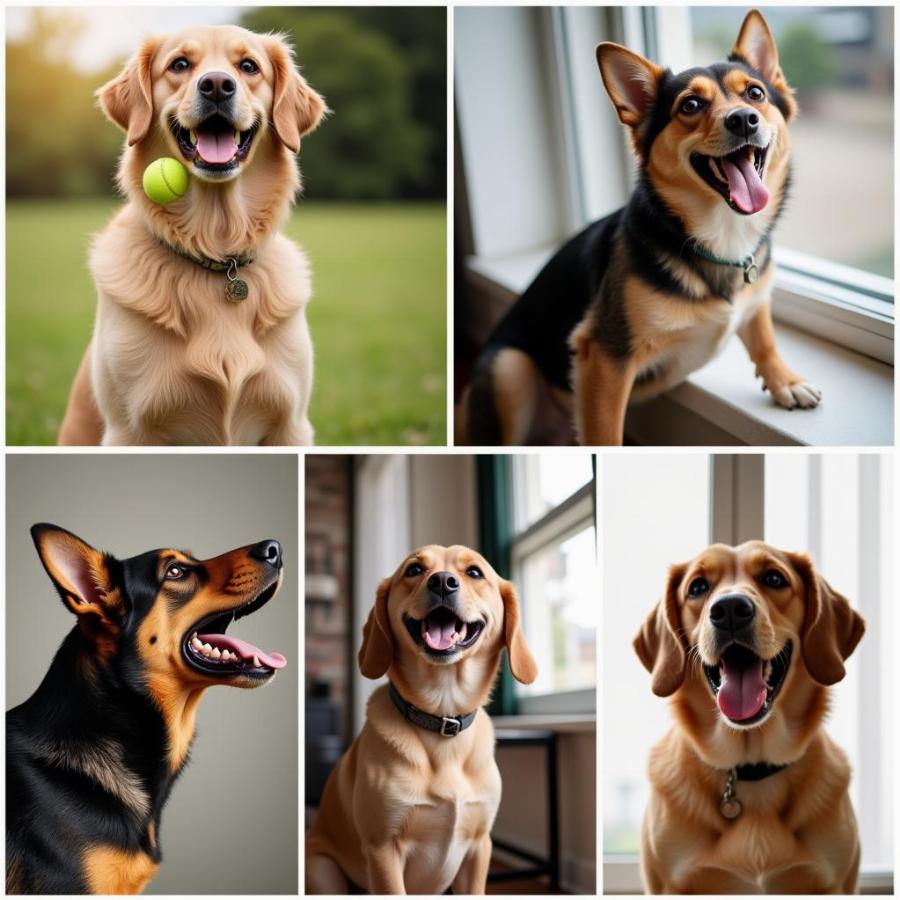As a cat owner, you’re well-versed in the symphony of meows, purrs, and hisses that make up your feline friend’s vocabulary. But what about those other four-legged companions – dogs? Understanding dog noises can be surprisingly beneficial for cat owners, especially if you’re considering expanding your furry family or have neighborhood dogs frequently interacting with your cat.
This article delves into the world of dog noises, helping you decipher their barks, howls, and whimpers to gain insight into their emotional state.
Decoding the Language of Barks: What Your Dog is Trying to Tell You
Just like we use words to communicate, dogs rely on a range of vocalizations, with barking being their primary mode of expression. However, a bark isn’t just a bark. Dogs have different barks for various situations, and understanding these nuances can help you interpret their needs and emotions:
- Alert Bark: A sharp, loud bark is often a way for dogs to announce the presence of something unusual or potentially threatening. This could be anything from the mailman to a squirrel scampering across the lawn.
- Playful Bark: Higher-pitched, repetitive barks often indicate a desire to play. This bark is usually accompanied by a wagging tail and playful body language.
- Demand Bark: This insistent, repetitive bark is your dog’s way of getting your attention. They might want food, a treat, or simply some cuddles on the couch.
- Frustration Bark: A lower-pitched, drawn-out bark can signal frustration. This might occur when your dog is bored, wants something they can’t have, or is feeling anxious.
- Territorial Bark: A deep, rumbling bark can be a warning sign that a dog feels threatened or protective of their territory. This bark is often directed at strangers or other animals.
 Different Types of Dog Barks
Different Types of Dog Barks
Beyond the Bark: Other Vocalizations and Their Meanings
While barking takes center stage, dogs use a variety of other sounds to communicate:
- Whining: A high-pitched whine often signifies anxiety, fear, or discomfort. It can also be a way for dogs to seek attention or express excitement.
- Howling: While often associated with wolves, howling is also a common dog vocalization. Dogs may howl to communicate with other dogs, express loneliness, or respond to high-pitched sounds.
- Growling: A low rumble in the throat is a warning sign. It signals aggression, possessiveness, or fear. Never ignore a growl, as it’s a clear indication that a dog needs space.
- Sighing: A deep, contented sigh usually means a dog is relaxed and happy.
Why Understanding Dog Noises Matters for Cat Owners
Cats and dogs might be the best of friends in some households, but their communication styles are vastly different. A dog’s bark, which might seem harmless to us, can be perceived as a threat by a cat, leading to stress and potential conflict.
By understanding the different types of dog noises and their underlying emotions, you can:
- Anticipate your cat’s reaction: If you know a certain dog bark triggers anxiety in your cat, you can take steps to create a safe space for them or manage their interactions.
- Facilitate positive interactions: Recognizing a playful bark can help you encourage safe and supervised playdates between your cat and dog.
- Ensure everyone’s well-being: By understanding and responding appropriately to dog vocalizations, you can create a harmonious environment for both your cat and any canine companions.
Tips for Introducing Your Cat to Dog Noises
If you’re introducing a new dog to your cat-loving household, gradual acclimation is key:
- Start with sound: Before the big meeting, allow your cat to hear your dog’s bark from another room. This can help them get used to the sound without feeling threatened.
- Use positive reinforcement: Reward your cat with treats and praise for calm behavior around dog noises.
- Create a safe space: Ensure your cat has a designated area where they can retreat if they feel overwhelmed by the dog’s presence or vocalizations.
When to Consult a Professional
If your cat exhibits extreme fear or aggression towards dog noises, or if you’re struggling to manage their interactions, consult with a certified animal behaviorist or veterinarian. They can help you address any underlying behavioral issues and provide personalized guidance.
Beaut Dogs: Your Partner in Pet Parenthood
Beaut Dogs is your go-to resource for all things dog-related. We provide expert advice, helpful tips, and a wealth of information to help you navigate the wonderful world of dog ownership. For personalized support and answers to your specific questions, reach out to us via email at [email protected]. Beaut Dogs is here to support you every step of the way.